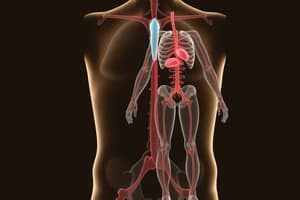Podcast
Questions and Answers
What happens when long bone growth stops?
What happens when long bone growth stops?
- Epiphyseal cartilage disappears and is replaced by bone. (correct)
- Chondrocytes begin to multiply rapidly.
- Osteoblasts become inactive in the growth plates.
- Growth Hormone levels increase significantly.
Which hormone is primarily responsible for stimulating growth in children?
Which hormone is primarily responsible for stimulating growth in children?
- Calcitonin
- Growth Hormone (correct)
- Ghrelin
- Thyroxine
How does ghrelin influence growth hormone?
How does ghrelin influence growth hormone?
- It directly increases the number of osteoblasts.
- It inhibits growth hormone release.
- It regulates body temperature affecting growth.
- It stimulates growth hormone release through the IP3 pathway. (correct)
At what age does Growth Hormone secretion typically decrease?
At what age does Growth Hormone secretion typically decrease?
What is the half-life of Growth Hormone?
What is the half-life of Growth Hormone?
What describes the process of hypertrophy in growth?
What describes the process of hypertrophy in growth?
What is the significance of growth plate fusion in human growth?
What is the significance of growth plate fusion in human growth?
Which factor does NOT influence human growth?
Which factor does NOT influence human growth?
What is allometric growth in humans?
What is allometric growth in humans?
What role do chondrocytes play in bone elongation?
What role do chondrocytes play in bone elongation?
What happens to cartilage as new cartilage forms?
What happens to cartilage as new cartilage forms?
During which growth period does the body undergo the most significant changes in growth patterns?
During which growth period does the body undergo the most significant changes in growth patterns?
What is influenced by both hormones and external factors during human growth?
What is influenced by both hormones and external factors during human growth?
Flashcards
Growth (in Biology)
Growth (in Biology)
The organized addition of new tissue during development, leading to an increase in size from infancy to adulthood.
What are the two main ways cells contribute to growth?
What are the two main ways cells contribute to growth?
Growth occurs through hypertrophy (increase in cell size) and hyperplasia (increase in cell number).
What else contributes to growth besides cell changes?
What else contributes to growth besides cell changes?
The extracellular matrix, the material surrounding cells, also expands during growth.
What is the pattern of human growth?
What is the pattern of human growth?
Signup and view all the flashcards
What are the major factors controlling growth?
What are the major factors controlling growth?
Signup and view all the flashcards
What is allometric growth?
What is allometric growth?
Signup and view all the flashcards
What is happening in the zone of proliferation in bone growth?
What is happening in the zone of proliferation in bone growth?
Signup and view all the flashcards
How does cartilage expansion contribute to bone elongation?
How does cartilage expansion contribute to bone elongation?
Signup and view all the flashcards
Epiphyseal Plate Closure
Epiphyseal Plate Closure
Signup and view all the flashcards
What is a sign of epiphyseal plate closure on X-rays?
What is a sign of epiphyseal plate closure on X-rays?
Signup and view all the flashcards
GH's Secretion Pattern
GH's Secretion Pattern
Signup and view all the flashcards
Ghrelin and GH
Ghrelin and GH
Signup and view all the flashcards
What is a Growth Hormone Secretagogue?
What is a Growth Hormone Secretagogue?
Signup and view all the flashcards
Study Notes
Human Growth and the Endocrine System
- Human growth is the organized addition of new tissue, occurring from infancy to adulthood. It involves lengthening of the skeleton (especially long bones) and an increase in size of soft tissues.
- Growth begins at conception and is largely complete in adolescence.
- Growth is an increase in size of a tissue or organism, caused by either hypertrophy (increase in cell size) or hyperplasia (increase in cell number), or an increase in extracellular matrix.
- Growth patterns are not linear, differing throughout development, including neonate, infant, and puberty stages.
- Major factors influencing growth include genetics, adequate diet, and the absence of chronic disease or environmental stress.
Allometric Growth in Humans
- Allometric growth refers to how different body parts grow at different rates. This leads to changes in body proportions from infancy to adulthood.
Growth Hormone (GH)
- GH is a 191 amino acid protein hormone.
- Its half-life is 19 minutes.
- It is secreted in a pulsatile fashion.
- Secretion is greatest in newborns, decreases at around age four, and then increases again during puberty.
- GH is released from somatotrophs in larger amounts than other pituitary hormones.
Pulsatile Secretion of GH
- GH secretion is cyclical, particularly prominent during sleep.
Pathway of GH Control
- GH secretion is controlled by a complex feedback loop involving the hypothalamus and anterior pituitary gland, as well as the liver and tissues.
- The hypothalamus releases GHRH and somatostatin, which stimulate or inhibit GH.
- The pituitary gland releases GH based on these factors.
- The liver and other tissues release IGF-1, which provides long-loop feedback.
Factors Affecting GH Release
- Various factors influence GH release, including hormones (like GHRH and somatostatin), nutrients (such as glucose, fatty acids), and stress.
Ghrelin and GH
- Endorphin-derived peptides stimulate GH release.
- Growth hormone secretagogues (GHS) stimulate GH release through the IP3 pathway.
- The GHS receptor was discovered in 1996.
- Ghrelin is the natural ligand of the GHS receptor, discovered in 1999.
Actions of Ghrelin
- Ghrelin affects appetite, gastric motility, reproductive function, glucose/lipid metabolism, and cardiovascular system.
- It also stimulates endocrine and exocrine pancreatic secretion, bone formation, and cell proliferation.
- It has anti-inflammatory effects.
Structure of Long Bones and Epiphyseal Lines
- Long bones are composed of diaphysis (shaft), epiphysis (ends), and metaphysis, containing growth plates.
- Growth plates are cartilage responsible for bone lengthening.
- When growth stops, the growth plate is replaced by epiphyseal line.
Control of Growth - Summary
- Growth is a controlled process influenced by genetics, diet, hormones, and environmental factors.
- The endocrine system plays a critical role in controlling the rate and pattern of growth.
Studying That Suits You
Use AI to generate personalized quizzes and flashcards to suit your learning preferences.




